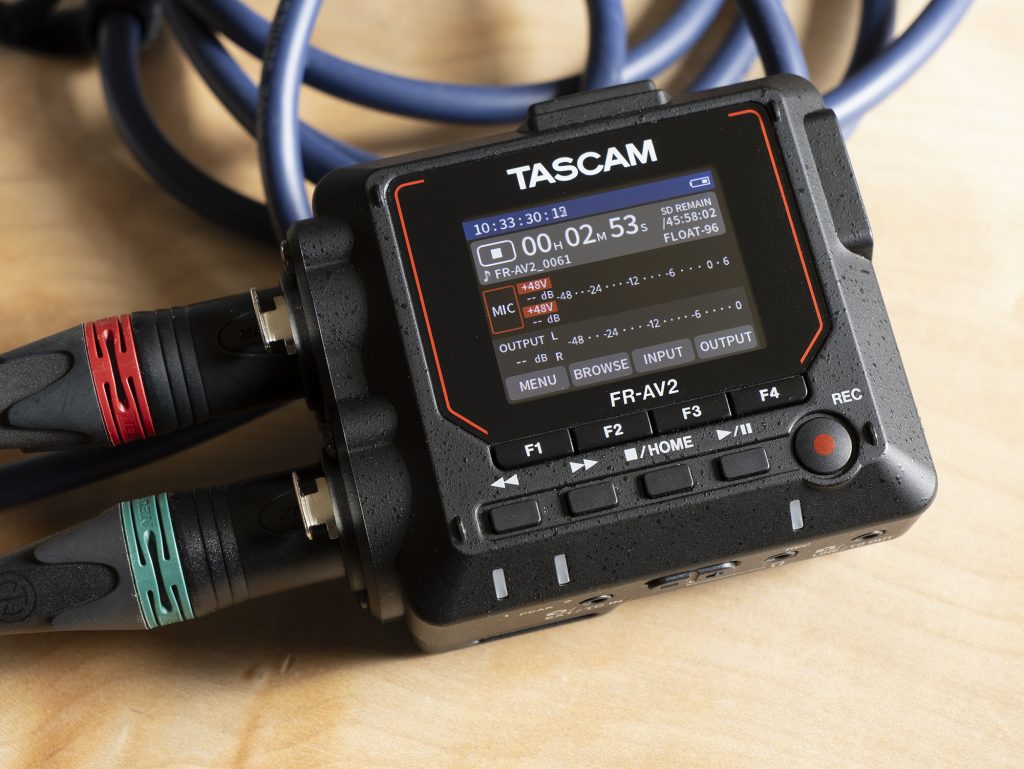
Introduction
Before getting into the blog post proper, I should point out that it comes with two caveats! First, I should clarify that this isn’t a full review of the Tascam FR-AV2 recorder: rather, it is a tale of dipping a toe in the water of 32-bit recording for me, exploring some of the aspects of such recorders that I have wondered about and about which I have struggled to find any authoritative analysis, let alone related to this specific recorder. It may well be that all these aspects are covered somewhere, but obscured by the smokescreen of so much (including a fair bit of nonsense) for and against dual-ADC 32-bit float field recorders. Whether I can add anything useful is another matter as, indeed, is the question as to whether anyone else is interested in the aspects of 32-bit float field recorders that have intrigued me. And, second, this post comes from the perspective of someone whose current main recorders are a pair of Sound Devices 788T recorders (one with a CL-8), along with a Sound Devices MixPre-3 for when I want lighter kit or simply don’t need the larger channel count. For a few years I also owned a Zoom F8n, but it has been a long time since I have bought, or even used, a cheaper and smaller recorder such as the FR-AV2. That said, in the increasingly distant past I have owned a Zoom H4, a Zoom H2n, a Tascam DR70D and a Sony M10: the last I valued as truly pocketable device, and was sad when it died. But I cannot claim to have had hands-on experience of the current options for, say, sub-£500 recorders, so please do bear that in mind!
Back in July 2024, when I last wrote about field recorders, I said ‘doubtless some find 32-bit float handy (e.g. for drop rigs for nature field recording, or for inexperienced recordists), but, personally, I see it as a solution to a problem I don’t have (without increasing mic input headroom – so many of these 32-bit recorders only have a 4dBu max mic input – and, also, introducing issues related to switching between ADCs)’, and to a great extent my feeling was the same a year on, before doing the tests outlined below. I’m not doing drop-rig or other unmonitored recording, and haven’t been bedeviled by recordings ruined by clipping nor, equally, suffering from self-noise arising from using excessively conservative gain. Moreover, most of the 32-bit recorders out there lack many of the features I value in my existing 24-bit recorders, with notable exceptions being the Sound Devices 8-series recorders: but I’m not in the market for one of these expensive recorders at present. So my interest in testing a 32-bit dual-ADC recorder came in a roundabout way (and, not, I hasten to add, because someone sent me a freebie: they didn’t!): with my little Sony M10 long dead, and just occasionally my MixPre-3 being not small enough for ultra-compact use, I wanted to buy a tiny recorder, which needed to have two channels of P48 (phantom power) and also to offer PIP (plug-in-power); to be able to handle mid-side recording, allowing recording of the M and S ISOs, while decoding to LR stereo for monitoring; to have no built-in mics; and to have decent-sounding preamps with low self-noise. Of the available options, the Tascam FR-AV2 seemed the best, if not only, candidate, and the required functions were certainly evident, although ‘decent-sounding’ preamps were not guaranteed (I have found no clear test), but there was reason to be optimistic: unless marketing hyperbole, the unit – with its ‘Ultra HDDA’ preamps – appears to have the same preamps as the excellent sounding but now discontinued HS-P82 recorder (it is unclear whether all Tascam’s ‘Ultra HDDA’ preamps are identical, but evidently there is at least some common ground). Its relatively cheap price (I paid £318 from CVP) was a bonus, although, of course, the flip-side of this is plastic construction and, perhaps, the absence of a few useful hardware features. While its 32-bit float dual-ADC design was rather incidental to my criteria for a tiny recorder, it, nonetheless, provided a good opportunity to explore such technology, so I think it would be fair to say that this was very much an extra reason to buy the recorder. And, of course, it is that aspect of the design that is the main subject of this post.
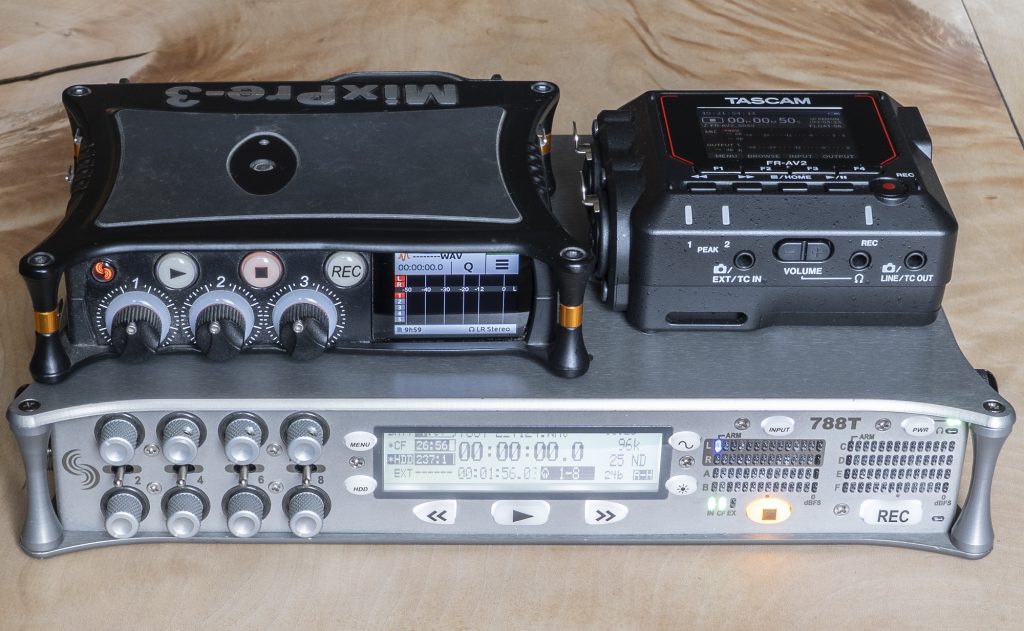
Overall impression
As I said, this isn’t a full review of the FR-AV2 and certainly not a re-hash of its specs, but a few observations might be relevant to those considering buying the device.
Physically, the plastic form gives it a budget feel (slightly toy-like, if you want to be harsh), but that very much comes with the territory at this price point. And, in case anyone is wondering why aluminium would be used beyond aesthetics and affectation (that premium feel!), decent preamps kick out heat and aluminium cases are often essential parts of heat management (my Sound Devices recorders get warm, as designed). A few slightly odd design features stand out immediately: the ‘premium’ (as Tascam names the non-Neutrik) XLR sockets have catches that are rather proud (liable to catch when stuffed in a pocket?); there’s a 1/4″ thread on the bottom, but why not 3/8″, which would have relevance to field-recording (described as an intended application of the FR-AV2), but which would also allow an inserted adapter for 1/4″ for the camera fraternity if preferred?; the battery door is one of those awful push-down-and-try-and-slide-off jobs, that is resistant to moving and will be a grim feature for someone lacking good grip or in some difficult field location (and you can’t, to mitigate this, charge the batteries while in the recorder); and, above all, the buttons have no back lights. Given the lack of a touchscreen (no big deal to me, though I like those of the MixPre recorders) the last seems decidedly odd: in low light, or with a half glance, it’s far from doddle to find the right button. Even some dimples on the ‘home’ button would help locate fingers.
Turning on the recorder, the screen is nice and clear, although the menu doesn’t seem quite as good as it could be (but there the recorder is in good company at any price point!) and there are some unexplained and annoying quirks. For example, why can’t the user have pre-roll (‘pre rec’) without having to have the pause option too? The immediate and unsatisfactory answer is that the latter also puts the recorder into standby mode, without which there is no pre-record, but the other recorders I use do not require a standby mode to have been pre-pressed (and for five seconds to have elapsed first): what on earth was Tascam thinking? More worryingly, the screen looks almost identical in recording and recording standby mode (surely the top part of the screen could be, say, orange for standby then red only when actually recording, rather than red in both instances?), although a flashing red LED indicates paused or standby mode vs the solid red LED of actual recording. It all seems a little prone to encouraging the classic error of thinking you are recording when you are not, which seems especially ironic given that a major part of the selling point of 32-bit recorders is easier use: reducing chances of cock-ups should be part of that.
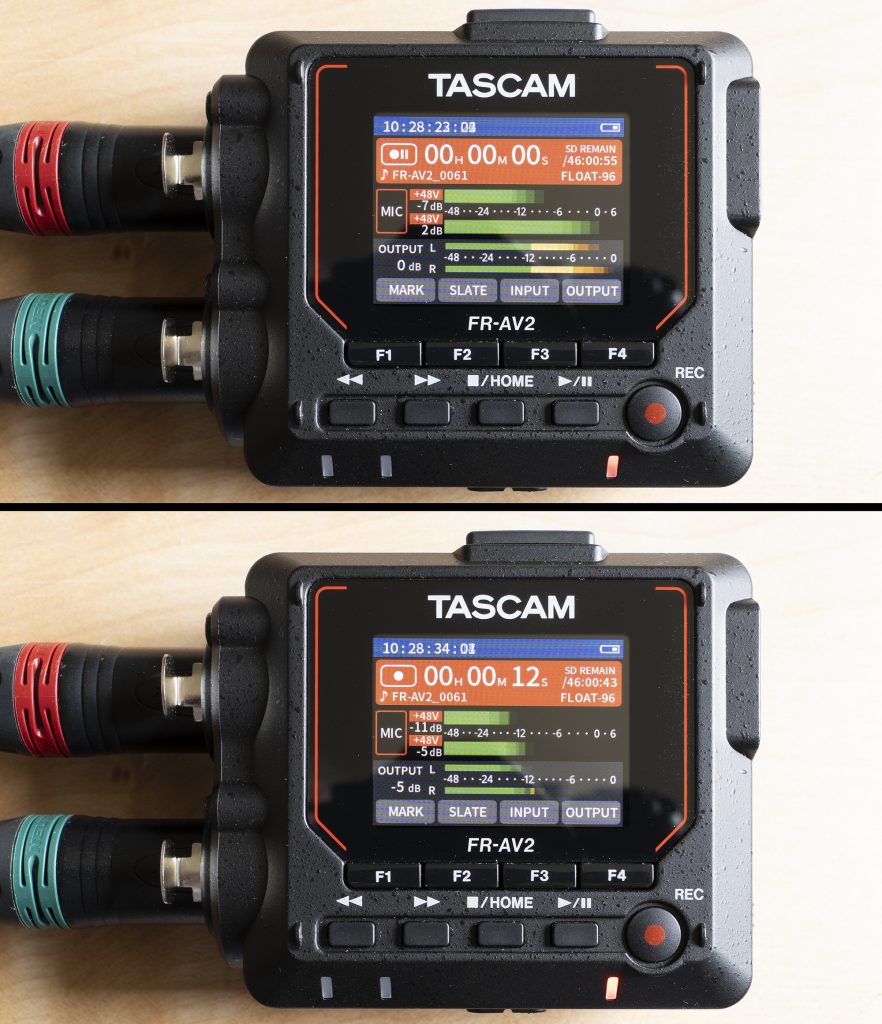
The FR-AV2 has a distinct advantage over the Zoom F3 (its most obvious competition) in that it has provision for MS recording. On the one side the implementation is needlessly clunky (why not have adjacent menu options for ‘stereo link LR’ and ‘stereo link MS’?), but, more positively, it is possible set gain for the two channels separately. While gain is to some degree irrelevant (see below), this difference carries through to your DAW, and gives precision when monitoring (more so than the ‘wide’ function, which is similar to the MS width option on a MixPre recorder). You can even ‘gang’ the inputs and change the overall gain whilst keeping the difference between the two channels intact. This means you can compensate in the field for the very normal situation of different sensitivities for your mid and side mics, though, evidently, you need to know those sensitivities and not confuse yourself by continuing to use these different gains when swapping to a pair of mics for LR stereo.
Plug-in-power (PIP) is another feature absent in the Zoom F3, but found in the FR-AV2 and, as I said in the intro, something I want in such a small recorder: a pair of PIP omni mics (such as any of the Primo EM272-based mics: e.g. the Clippies from Micbooster) makes for a very compact rig for when travelling with the most minimal sound equipment. And, it is good to see that the FR-AV2 offers a choice of 2.5V and 5V: many of these mics benefit from something less anaemic than the common 2.5-3.0V.
Moving on to outputs, the FR-AV2 has a fairly modest headphone amp, delivering 50 mW + 50 mW into 32 Ω, which is less than the hardly stellar Zoom F8n I used to own (100 mW + 100 mW) into 32 Ω, and is well short of the 300 mW + 300 mW of the MixPre-3, but proves usable with my HD-25s (70 Ω) and, if needed, you can always crank up the recording level (without fear of clipping the actual recording) near to the peak output level for monitoring.
Turning to getting your recordings off the FR-AV2, the USB connection seems poorly implemented: just shifting a stereo file to your computer takes an age, which is surprising in such a new device. In the comparative samples I have moved from recorder to PC while testing, USB data transfer rates have been around four times slower than my MixPre-3 (2017 technology) and seven times slower than my 788T (2008 technology)! This seems bizarre. But at least it’s only a two-channel recorder!
So a mixed bag: a far from ideal recorder, with some of the obvious hardware improvements being cost-neutral to have implemented, some (such as the backlit buttons) that would have been worth a modest price increase. The software-related issues, of course, are open to being fixed in a future firmware release, but I have no idea whether Tascam will be responsive (I have provided feedback and so far the response has been about as far from Sound Devices as possible!). I am uncertain whether the competition at this price point is better or worse in terms of hardware design and software implementation: doubtless there are YouTube reviews, blogs and forums full of comparisons between the FR-AV2, the Zoom F3 and other obvious competitors that cover this, and, indeed, discuss aspects I haven’t touched on here (e.g. the FR-AV2’s implementation of timecode and Bluetooth). And perhaps some of the quirks that have surprised me will be seen more positively by others: I could well be missing something!
Right, let’s get on with the 32-bit float recording side of things…
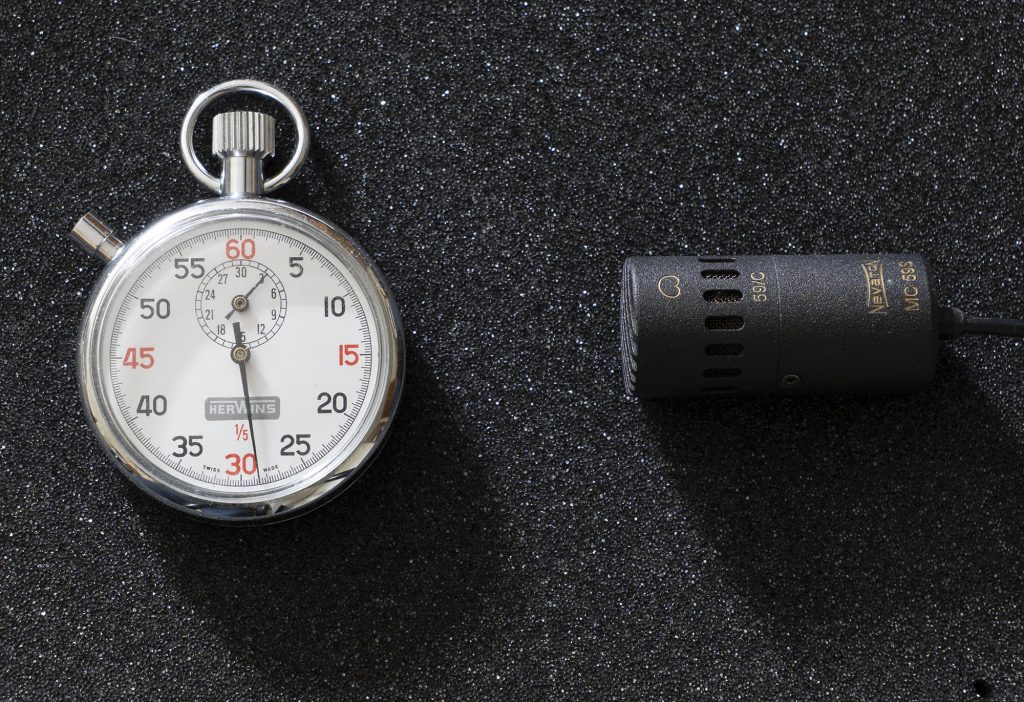
Recording level
Funnily enough, when doing a bit of background reading on the FR-AV2 I noticed some confusion about the recording level options, so, given that the manual sheds no light at all on this (a little surprising!), it is probably worth being crystal clear here. The setting of recording levels in 32-bit float mode (at least) does not bake in any analogue trim/gain: it is to help set levels for monitoring and outputs, to allow compensation to be made in the field for different mic sensitivities in the two channels (most obviously for MS recording), and to set the levels at some more immediately useful level for when you bring the recordings into your DAW. To double-check this I recorded a mechanical stopwatch in the quietest location I could manage (in an impromptu enclosure, under a pile of duvets, in the quietest room of the house, and with the electricity turned off!) and using an extremely low self-noise mic (Nevaton MC59/C: an apposite choice given that Dmitry and Egor at Nevaton suggested the mechanical stopwatch approach for mic tests) at recording levels of 0dB,+ 20dB, +40dB and +60dB, then brought the files into Reaper, adding/subtracting gain there so that the overall gains from the recorder plus in post were matched: all four adjusted recordings sounded identical, with no difference in self-noise. Voila: as expected!
On a related note, the peak level indicators (a red LED for each channel), which the manual describes as lighting up ‘when the input level exceeds the peak level’ are dependent on the recording level setting, so their function isn’t as indicators of mic input overload, but as indicators of overload of the outputs: i.e. to the headphones and if running a line out to camera. The indicator for overloading the analogue inputs of the recorder is, rather, the fact that the level indicator meter for the input channel will turn entirely red, as opposed to its normal green: if not red, peaks will be recoverable in post irrespective of the recording level settings and any indicated output level overloads. And, just to double check, I tested this too. Again, voila: as expected!
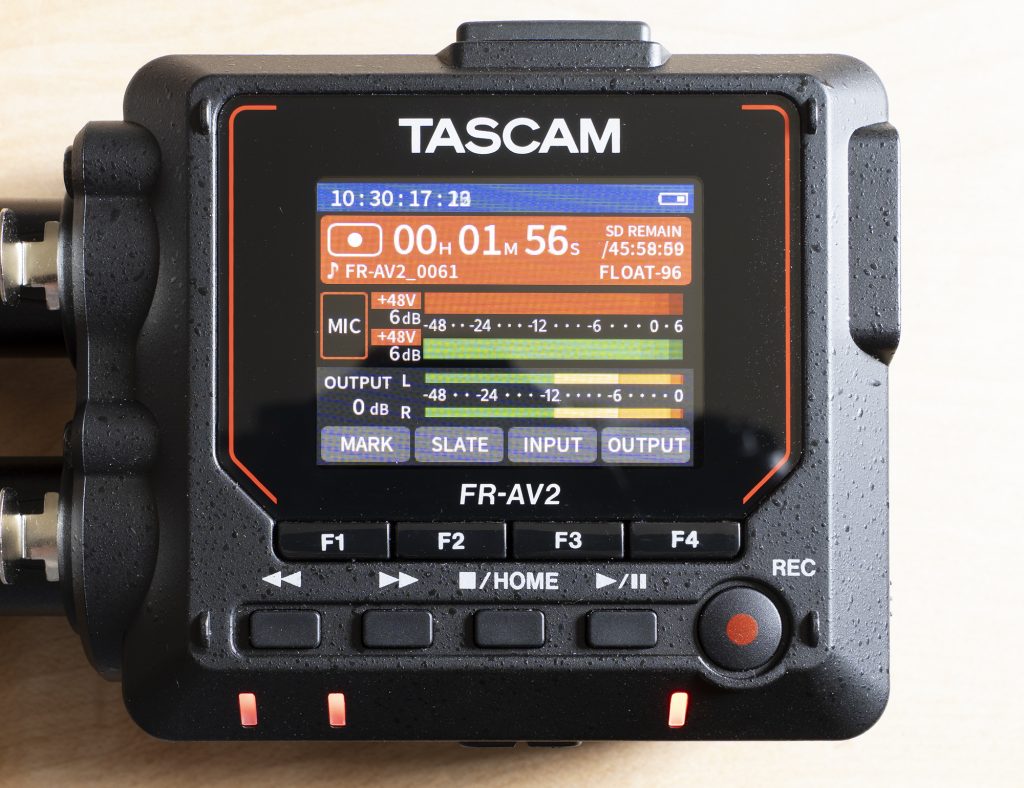
Self-noise
Following on from recording levels, and the consistency in self-noise irrespective of the setting, what then of absolute self-noise? Given that level setting of the FR-AV2 lacks the clarity of a more conventional recorder with trim/gain, I repeated the mechanical stopwatch test, using a Rode NT1 mic (for its very low [4dBA] self-noise), and compared it to a MixPre-3 (first generation: i.e. 24-bit) and a 788T using a passive three-way splitter. I set the FR-AV2 recording level at +40dB, although, as we have seen, this will make no difference to the self-noise, and then recorded parallel clips with the MixPre-3 and 788T at 76dB gain (i.e. the maximum gain on both) and then 56dB, 36dB, 16dB and 6dB gain (the last being the minimum gain possible on the MixPre-3). In Reaper I then raised the level of the FR-AV2 clips to match the 76dB-gained MixPre-3 and 788T clips, and then raised the remaining progressively quieter MixPre-3 and 788T clips to match (i.e. in turn adding 20dB, 40dB, 60dB and 70dB of gain in post). The results of the tests can be heard (and downloaded) below (and if you want to cut to the chase, just listen to the FR-AV2 and MixPre-3 clips in test 5!): and don’t forget, these are massive gain levels applied to three extremely quiet recorders and a mic that is as quiet as they go.
First: the two 24-bit recorders at max input gain (76dB) and the FR-AV2 with its level raised in post to match:
Second: the two 24-bit recorders at input gain of 56dB with 20dB gain added in post, and the FR-AV2 with its level raised in post to match:
Third: the two 24-bit recorders at input gain of 36dB with 40dB gain added in post, and the FR-AV2 with its level raised in post to match:
Fourth: the two 24-bit recorders at input gain of 16dB with 60dB gain added in post, and the FR-AV2 with its level raised in post to match:
And, finally, fifth: the two 24-bit recorders at input gain of 6dB with 70dB gain added in post, and the FR-AV2 with its level raised in post to match:
Sorry about the slog for anyone who actually went through the clips and compared them!
There are three aspects of these self-noise comparison tests that merit comment:
• First, the three recorders have indistinguishably similar self-noise when the two 24-bit recorders were gained to suit the quiet sound source, which is not surprising from the specs: equivalent input noise (EIN) of the FR-AV2 is –127 dBu, while that of the MixPre-3 is -128dBu and the (oddly unspecified) 788T is apparently -128dBu too.
• Second, the self-noise of the FR-AV2 means that it is very effective for recording quiet sounds (OK, this is obvious from the specs, but it is perhaps useful – given the confusion that surrounds dual-ADC 32-bit float recorders – to be reassured that this applies to the quietest signals).
• Third, and I suspect this may well be a big surprise for some, the 24-bit MixPre-3 recordings showed no more evident self-noise if recorded with 76dB (the maximum) gain or extremely low 6dB gain (i.e. its minimum mic input setting) with 70dB gain then added in post. The 788T recordings behaved similarly (i.e. no more self-noise) until gain on the recorder was dropped to 16dB (so the point where self-noise increases is somewhere a little above this) and at 6dB (with 70dB added in post) the recorder was noticeably hissier. Obviously, a mic with more self-noise would mask this and bring the effective constant self-noise lower, nearer to the MixPre-3.
The third point reinforces the lack of need to record at very hot levels with a 24-bit field recorder with decent preamps and, a point often missed, the 24-bit MixPre first generation recorders have no additional self-noise across the whole trim/gain range from 6dB to 76dB (they have a quite different preamp and ADC design to the 7-series recorders, with two op amps per channel feeding into two ADC channels per mic input, which are then combined in the ADC: here is an informed tear-down of a first generation MixPre-6).
Clipping
This leads neatly onto the subject of clipping. Now this was something about which I had no prior doubt: despite the much-touted no clipping side of dual-ADC 32-bit float recorders, this cannot compensate for overloading the mic input. Like many budget recorders, the Tascam FR-AV2 has a fairly modest +4dBu maximum input level for microphone input, when the gain is at minimum. This isn’t unusual, and can be found outside the small handheld recorders with which, perhaps, the FR-AV2 is most likely to compete: it is, for example, the same as the Zoom F8n Pro. The last is odd, since the preceding (24-bit) Zoom F8n (which I used to own) had a significantly higher maximum input level of +14 dBu, as does my MixPre-3 (first generation): the second generation MixPre-recorders (i.e. with 32-bit float and dual ADCs) also have a maximum input level of +14 dBu. Turning to my older 788Ts, these offer mic inputs with +8 dBu maximum (but, note, when gain = 10 dB, yet trim/gain for mic inputs can be reduced to 0.1dB); and, for line inputs +26 dB maximum (gain = 0 dB): the last might seem irrelevant to mics, but, crucially, the 788T can supply 48v phantom power when in line-input mode. The current 8-series recorders from Sound Devices have almost exactly the same input specs as the 7-series (though slightly more line-level headroom at +28dBu) and also allow P48 in line-input mode. Looking at another example of a current professional recorder, the Sonosax SX-R4 has a + 21dB max mic input level. So, if on the deck of an aircraft-carrier recording jets landing, any of the Sound Devices or the Sonosax (and other similar professional) models will see you home sans clipping (as long as your mics can handle the SPL) while the Tascam FR-AV2 is likely to struggle. The higher maximum input levels of my other recorders has certainly been put to good use a few times by me (e.g. when close-miking loud bands with condensers) and are there for good reason, not for some only theoretical need. And turning to my own tests for this post, using a sensitive mic (an MKH 8060 shotgun), I found a simple hand clap enough to get the Tascam FR-AV2 to overload the inputs, while the 788T had no trouble at all.
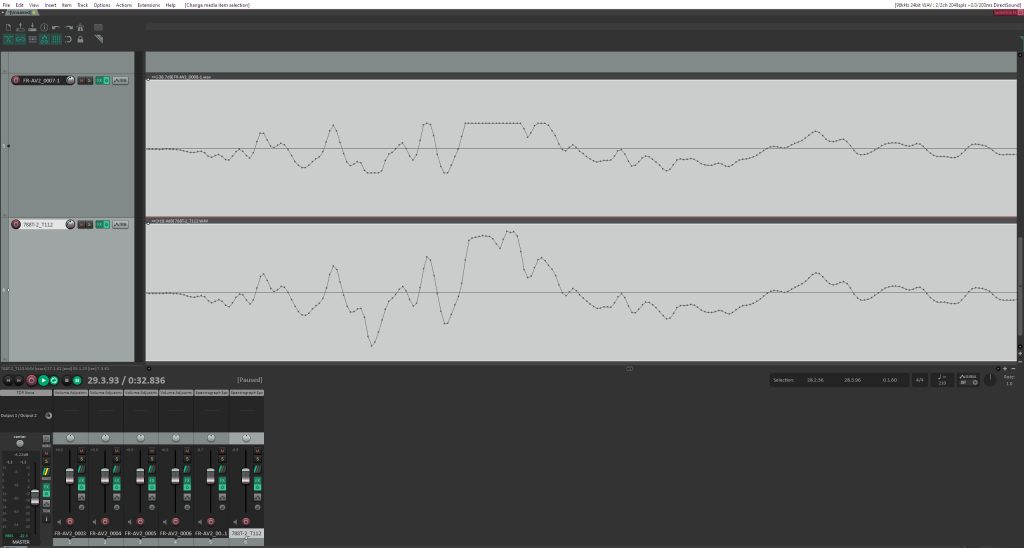
Now the MKH 8060 is capable of outputting a maximum of around +12dBu, which is by no means unique, so, as with all such common +4dBu inputs on more modest recorders, you just need to bear this in mind and remember that the 32-bit float format doesn’t solve the hardware limitations of the FR-AV2 and its ilk. If recording extremely high SPLs with sensitive mics with no built in pads, then make certain to pack a couple of, say, 20dB in-line attenuators (make certain they have P48 pass-through). Likewise, the user needs to be beware of mics with modest maximum SPLs causing clipping earlier in the chain. But, for most use by most users, the Tascam FR-AV2 should be fairly clip proof, and is certainly less likely to result in clipping in most common usage than a poorly or non-monitored 24-bit recorder, a 24-bit recorder set with too high an input gain (possibly, as we have seen, out of an irrational fear of getting too low a recording and burying signal in preamp self-noise), or when recording an unexpectedly wide dynamic range. So, yes, of course, in many cases the Tascam FR-AV2, or similar, will help recordists avoid clipping.
NB If you don’t have an expensive 24-bit recorder aimed at production sound professionals, or a more modest 32-bit device such as the FR-AV2, the tried and tested alternative of dual-recording (where, say, a stereo pair is recorded at two different gains to two pairs of channels) is found on many a 24-bit recorder, including the modest but great value Tascam DR-70D.
Recording extreme dynamic ranges
Taking these thoughts and tests on self-noise and clipping forward, the oft-cited benefit of dual-ADC 32-bit float recorders is their performance in situations where there is unpredictable and extreme dynamic range. Recording both gentle rain and thunder claps is one example often given. Weather is a fickle thing and we don’t have much in the way of thunder storms in Norfolk anyway, so for a more mundane, but equally telling, test I headed outside and went for the combination of a coin spinning, a burst from a hammer drill (drilling into concrete) 300mm from the mic (this time an MKH 8020 omni SDC mic, with still very respectable 10dBA self-noise), and also the quiet background noise of a few birds tweeting and the distant rumble of a military jet: this presents a huge dynamic range . For the tests, I compared the FR-AV2 (set with ‘rec level’ at 0) with the MixPre-3 (gain at the minimum of 6dB) and the 788T (gain set at 20dB, so that the level indicators were at the top of the orange band and just shy of the red for the drill sound: i.e. how many might record the drill, but not the quiet sounds). In none of the three cases was the signal loud enough to overwhelm the mic input stage: the aim was to give the FR-AV2 a fair test and not simply reveal the limitation of its analogue mic inputs again. With 6dB gain on the MixPre-3, this was recording very conservatively for the drill sound, let alone the quiet background and coin spinning, so headroom for any louder still sound was considerable (as it turned out, a substantial 21dB) and well short of limiter territory. Here are the three recordings, unedited apart from the levels of the FR-AV2 and MixPre-3 recordings raised a little to match the 788T recording (by use of a 1kHz tone, which is included in the clips, with a narrow band-pass filter applied):
As expected, the overall recordings sound pretty much identical, but, of course, with extreme dynamic range (and think back to the thunder and soft rain example), the recordist will often want to edit the recording so that the loud and the quiet parts are both audible – in short raising the quiet part. You can download and play with the files and try this yourself, of course, but, as a more immediate alternative, here are some short excerpts from these recordings to show the consequences of doing this on the quiet sounds, first of the coin, with the level of each recording raised in post by another 30dB from the full-length recordings above:
And here are some short excerpts of the distant and faint bird (and jet plane) sounds from the full-length recordings above, this time with the matched levels raised by a whopping 50dB in post:
To my ears the recordings sound largely identical, and, certainly, there is nothing different in terms of self-noise. Even the previously observed slight rise in self-noise of the 788T at very low gains and with a low self-noise mic (i.e. at 16dB gain with the 4dBA Rode NT1) is no longer evident with the recorder at 20dB gain and with the MKH 8020 (10dBA) mic. Food for thought for some perhaps? Slightly ironically, this serves as a reminder that conservative gain settings on a 24-bit recorder (plus, of course, decent limiters though they were not used in this test) may well cover the issues of the unexpectedly loud sound (and consequent fear of clipping) that have led many to buy a dual-ADC 32-bit recorder!
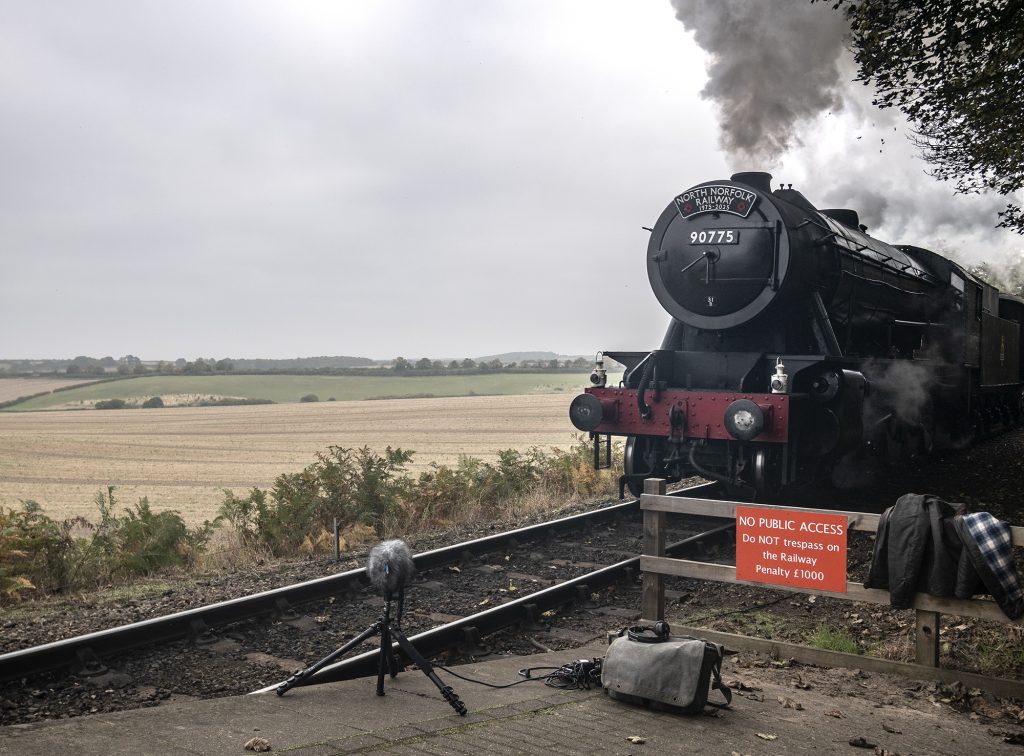
And for another example, I popped along to nearby Kelling Heath Halt on the North Norfolk Railway, for a bit of field recording with a huge range in sound levels. Here, the little halt station (a request stop) is not used by trains on the upward incline from Weybourne, so is a good place to be able to place mics right by the wheels (and cylinders) as the locomotives come past working very hard. And I was especially in luck this time, as the steam loco that passed was one of the largest on the line. The recording was made using a Sennheiser MKH 8018 stereo shotgun into the FR-AV2 and, again, the MixPre-3 set at its minimum gain of 6dB. Here are the two recordings with 15dB gain added in post to the MixPre-3 recording and the FR-AV2 leveled to match (and, also, the fig 8 side channel of the MKH 8018 was also given an additional 7dB gain in post to match its sensitivity to the mid mic capsule):
As before, you can download the wav files to play with them yourself, but, again, to make things easier here are two very short excerpts from the quietest parts, with much more gain added in post: another 65dB gain was added in post, giving a total of 80dB gain to the MixPre-3 field recording (plus, of course, that additional 7dB for the less sensitive fig 8 side capsule).
Again, there is significant difference between the dual-ADC 32-bit float FR-AV2 and the 24-bit MixPre-3 recordings, and no difference in self-noise even when the low level MixPre-3 recording is pushed to extreme measures in post. The MKH 8018 is a very high output mic (56mV/Pa; -25 dB ref (1V/Pa)), and yet the MixPre-3 recording had 19.4dB of headroom above the peak level for that channel (and much more for the fig 8) and, of course, came nowhere near needing its effective limiters. In normal use I would not have set the MixPre-3 gain quite as low as for this demonstration, mainly to aid monitoring. Given the ability of the MixPre-3 to recover extremely low-level signals (without any self-noise penalty) just as well as the FR-AV2 (and, obviously, similar 32-bit float recorders with very low EIN), and its greater ability to handle high input levels, it is difficult to imagine a scenario where extreme variation in sound levels and the wish to raise quiet sections whilst editing means that the FR-AV2 and similar recorders offer any performance advantage.
NB Don’t be mistaken: I am not advocating that, if you have a first generation MixPre recorder that you should leave it permanently with the gain at 6dB: for quiet sounds you will struggle to monitor (through headphones and on the meters), will have low output levels, and will find the waveforms nigh on invisible when you take the files into your DAW. And if you pass files on to someone else for post you will be decidedly unpopular.
Switching ADCs
There are blogs, videos and forums that have demonstrated, illustrated and discussed the issue of switching ADCs in dual-ADC 32-bit recorders (and, indeed, dual-ADC 24-bit recorders such as the Sony D100 that also use switching). By issues, I mean the effects of the on-the-fly switching of the source of the recorded signal from the low-gain ADC (i.e. that for high-level audio) to the high-gain ADC (i.e. that for low-level audio) and vice versa. The main problem, insofar as it is a problem at all, appears to be the jump in self-noise when the switch is made between the ADCs: at face value, this seems unlikely to be an issue if the change in self-noise is masked by the signal. The key then would seem to be if switching ADCs can be heard on the fading tails of sounds. Of course, there may be more to the different ADC performance than self-noise (distortion, for example), and, with this in mind, I have wondered about any implications for different ADCs being used for different channels (both for L and R stereo and especially, M and S pairs) due to significantly differently levels. I have yet to find anything crystal clear on this (apart from a few seemingly well-informed comments). Being nothing of an electronics engineer, I am poorly equipped to understand, analyse and communicate exactly what is going on with switching dual-ADC designs, but that puts me in the same boat as most who choose between single-ADC 24-bit recorders and dual-ADC recorders (be they 24-bit or 32-bit). So, for me there are two practical tests I can do with the FR-AV2: first, see if the switching of ADCs is observable; and, second, and more importantly, see if the switching can be heard.
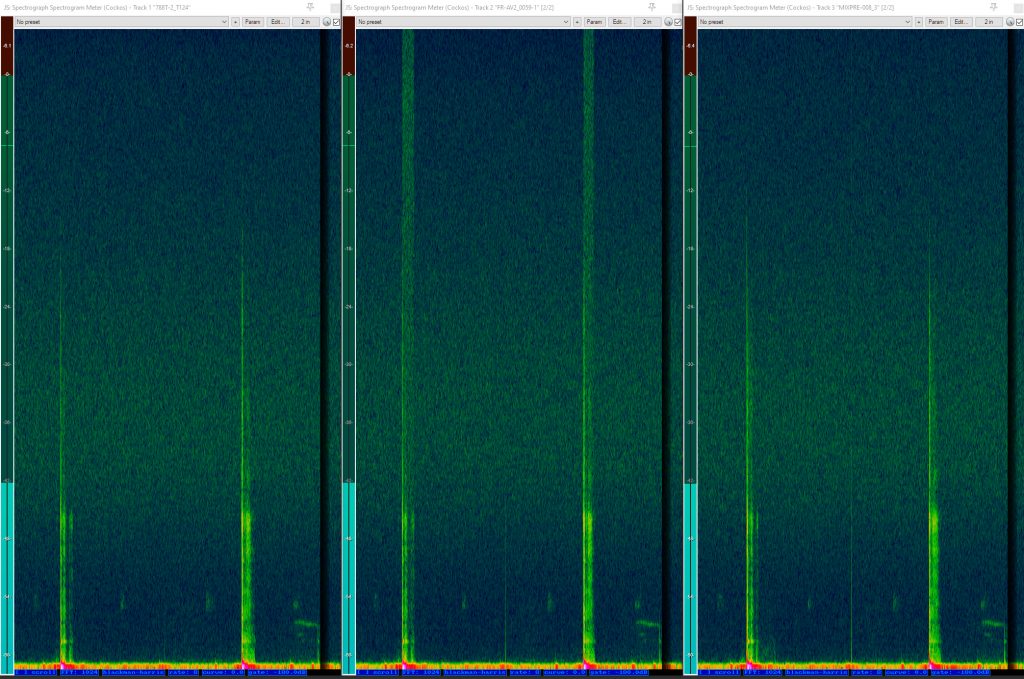
Well the observable part is easy in the sense of visual indication on a spectrogram, as shown above: in this example (using the FR-AV2, MixPre-3 and 788T, with levels matched by a 1kHz tone) some gentle taps on the mic body (MKH 8060) to cause high-level low-frequency peaks are accompanied by a jump in self-noise in the FR-AV2, which I crudely measured at about 10-20dB, but only distinguishable from around 24kHz. But as the sound level drops, so quickly does the ultrasonic self-noise, as the recorder switches ADC. Here are the sound files from which the above was derived:
I’ve played around with this and other tests, dropping the pitch a couple of octaves (relevant to some sound design) doesn’t lead to any obviously audible switching-related increase in noise or other artefacts. As I said, I have no claim to have any expertise in this, but my conclusion – from a sound recordist’s perspective – is that the FR-AV2’s implementation of switching between its dual ADCs has no audible effect: but if someone can show differently that would be interesting!
Conclusions
Well first off I should say that I am happy with the Tascam FR-AV2: I bought it for its tiny size and other key features described in the introduction. With its dual-ADC and 32-bit float design it delivers low-self noise across what, in normal terms, would be described as any gain level. This is very different than was the case with the 24-bit cheaper handheld recorders I have owned in the past. I think that this is the crucial point: prospective purchasers of this and similar recorders (say the Zoom F3) are going to be comparing them to budget 24-bit recorders.
But when compared to my (first generation) MixPre-3, the FR-AV2 offers no practical advantage in high dynamic range recordings: it offers no better ability to bring up the quiet sounds in post, while handling extreme loud sounds at the same time and, as we have seen, has less capability of handling extremely high mic input levels. The last may not be an issue for many, or even most, users, so perhaps we could say that for most the two recorders are equal in this regard and that all the FR-AV2 does is solve the ‘issue’ of the MixPre-3/6/10 user who is inexplicably afraid of setting trim/gain at very conservative levels for such use! Now, of course, not all non-budget 24-bit recorders exhibit such consistent self-noise and dynamic range across the whole trim/gain range (as we have seen here with the older 788T: although in practical use – as in the recordings of the hammer drill etc. and the steam train – this is hardly significant), so that means you need to know exactly how your recorder performs (and not just with a 150k resistor shorting the inputs, but with mics that you will use: their self-noise will come into the equation).
As for the switching ADC issue, I am relieved to find that this seems much less of a concern than the on-line discussions and demonstrations might suggest: that might reflect my ears, my use and, indeed, that the FR-AV2 is a more recent dual-ADC and 32-bit float design. So, yes, through testing the FR-AV2 I have modified my view from July 2024, when I wrote about field recorders and said ‘doubtless some find 32-bit float handy (e.g. for drop rigs for nature field recording, or for inexperienced recordists), but, personally, I see it as a solution to a problem I don’t have (without increasing mic input headroom – so many of these 32-bit recorders only have a 4dBu max mic input – and, also, introducing issues related to switching between ADCs)’: certainly with regard to the FR-AV2, I don’t have the ADC switching concern, though perhaps am just left with a niggling, lingering feeling – however irrational perhaps – that something isn’t quite right and that, for a critical – say music – recording, I would stick to a non-switching dual-ADC recorder. This is rather theoretical anyway for me personally, as given the channel count of the FR-AV2, its less than ideal ergonomics and its lack of so many other features, I would be highly unlikely to use it for an acoustic music recording. That said, I will try and remember to take a split of the main pair on some future music recordings to really give those ‘Ultra HDDA’ preamps a good check: so far, I think they sound fine. And, in the meantime, although the dual-ADC and 32-bit float aspect of the recorder remains a solution to a problem I don’t have, I would have no hesitation in using the FR-AV2 for sound effects or field recording should I need something smaller than my MixPre-3. The FR-AV2 has met my specific needs, but, of course, may well have a much wider application for many and, for them, offer significant advantages over existing or alternative options.









